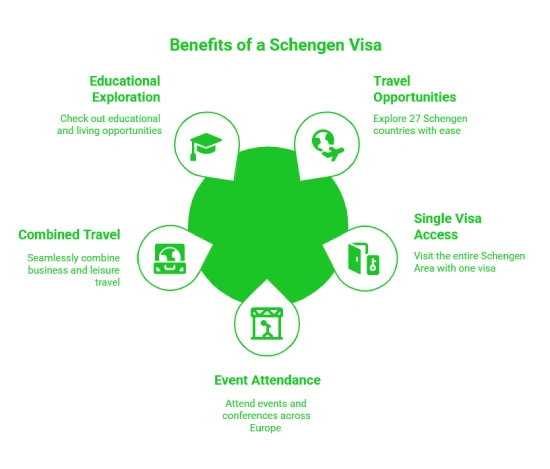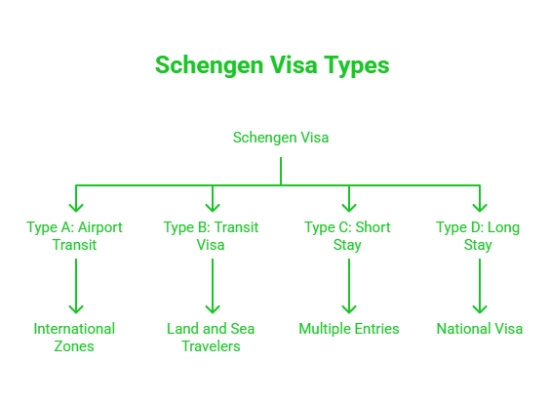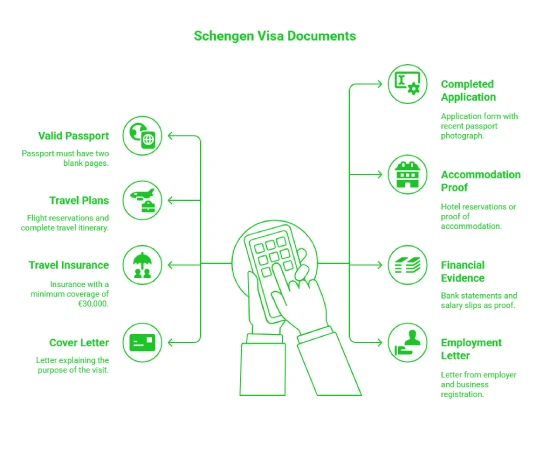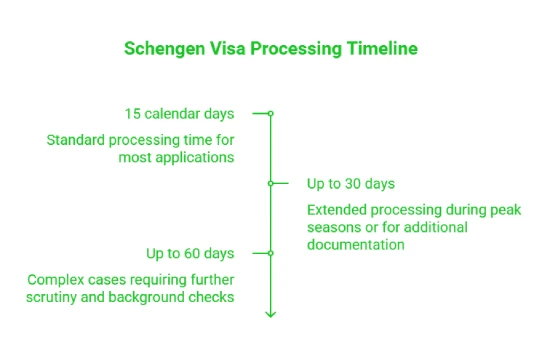Why apply for a Schengen Visa?
A Schengen Visa you gives you access to all 27 European countries which operate under this single visa system. The Schengen Visa simplifies cross-border travel and saves both time and money for people who need to visit European countries for vacation business or family trips.
- Enter 27 European countries with a Schengen visa
- Issued 9.7 million Schengen visas
- Travel within any 180-day period is 90 days
- Average wait time for processing visa applications is 15–30 working days.
- Visit Europe for tourism, business, family visits and study purposes
What is a Schengen Visa?
A Schengen Visa is a short-stay permit allowing non-EU travelers to visit any of the 27 Schengen countries for up to 90 days within a 180-day period. This single visa enables free movement across internal borders of member states.
List of Schengen Visa Countries
The Schengen area has 29 countries that maintain their own rules, policies, and visa application timelines.
The table below has the list of Schengen visa countries:
|
Austria |
Liechtenstein |
|
Belgium |
Lithuania |
|
Bulgaria |
Luxembourg |
|
Croatia |
Malta |
|
The Czech Republic |
The Netherlands |
|
Denmark |
Norway |
|
Estonia |
Poland |
|
Finland |
Portugal |
|
France |
Romania |
|
Germany |
Slovakia |
|
Greece |
Slovenia |
|
Hungary |
Spain |
|
Iceland |
Sweden |
|
Italy |
Switzerland |
|
Latvia |
|
Who Needs a Schengen Visa?
You must apply for a Schengen Visa if you are a citizen of a visa-required country, such as India. Even if you hold long-term residence in a visa-exempt country, you still need a visa. Only citizens from visa-exempt nations (e.g., U.S., UK, Canada) using an eTA or ETIAS do not require it.
Benefits of obtaining a Schengen visa
- Explore 27 different Schengen countries.
- Visit the entire Schengen Area with a single visa
- Gives you the permission to attend events, exhibitions or conferences that take place throughout Europe.
- Business and leisure travel can be seamlessly combined together.
- Allows students and residents who want to check out educational or living opportunities in Europe.

Types of Schengen visa
Schengen Visas come in different forms according to their purpose and duration of stay. Schengen Visas divide their classification based on the travel purpose and time duration, which leads to multiple categories.
Type A Schengen visa or Airport Transit Visa
This visa provides travel clearance to individuals passing through the Schengen Airport international zones.
Type B Schengen visa
Type B Visa serves as a transit visa for land and sea travelers who can stay up to 5 days in the Schengen Area. Current usage statistics show its decline, although some countries continue to follow this visa type in their documentation.
Type C Schengen visa
This visa category serves as the standard visa for travelers who want to visit the Schengen Area for periods of up to 90 days. The multiple-entry system allows travelers to use their visas for more than one visit.
Type D Schengen visa
The Type D Schengen visa permits travelers to stay in one Schengen country for more than 90 days. The visa holder can also visit other Schengen states during the 180-day period for up to 90 days. The national visa gets issued through the embassies of each country.

Eligibility for a Schengen Visa
You can make a Schengen Visa application if:
- Your nationality requires you to hold a Schengen Visa.
- Your passport remains valid for the last 10 years with an additional 3 months of validity after your planned return date.
- The purpose of your trip can be proven through documentation that includes hotel bookings or an invitation letter.
- You need to have enough money to cover your trip expenses.
- You must demonstrate clear plans to go back to your home country.
- You must fulfill the health insurance and travel insurance requirements for your application.
Schengen Visa Requirements
Individuals who apply for a Schengen visa must provide the following requirements:
- The Schengen Visa Application Form needs to be fully completed and signed correctly.
- Two recent passport photos are necessary, which must be identical in color and taken during the preceding six months according to visa photo guidelines.
- The passport copy needs to be valid for at least three months more than the planned visit period and must be issued within the last decade.
- The cover letter must provide a detailed explanation of why you want to visit Europe and the exact dates of your trip.
- The visa requires a confirmed round-trip flight booking to demonstrate your entry and exit from the Schengen Area.
- The visa applicant must provide either hotel bookings or rental agreements or a host’s invitation letter with address for accommodation evidence.
- Your travel insurance certificate requires a minimum coverage of €30,000
- Depending on your profile and visa type, you may need to submit bank statements along with employment letters and invitation letters.
Documents required for a Schengen visa application
| Factor | Schengen Visa (Type C) | National Visa (Type D) |
| Purpose | Short-term stay (tourism, business, family visit, transit) | Long-term stay (work, study, family reunification) |
| Duration | Up to 90 days within a 180-day period | More than 90 days |
| Validity | Valid across all 27 Schengen countries | Valid only in the issuing country |
| Number of Entries | Single, double, or multiple entry | Usually single entry; long-stay residence permit follows |
| Application Authority | Embassy/consulate of main destination or first-entry country | Embassy/consulate of the specific country of long-term stay |
| Biometrics Required | Yes | Yes |
| Work Permission | Not allowed | May allow work depending on the visa type (e.g., work permit) |

How do you apply for a Schengen Visa?
Step 1: Identify the visa type
Identify the Schengen country where you will spend the most time or first enter, and apply through its embassy or consulate.
Step 2: Book an appointment
Your first step involves booking a visa appointment at the admission office, consulate, or visa application centre (e.g., VFS Global or BLS International).
Step 3: Complete the visa application form
Accurately fill in the official Schengen Visa application form. Multiple consulates provide online applications that you can also download.
Step 4: Prepare your documents
You need to collect all necessary documents, including passport, photographs, travel insurance, proof of funds, flight itinerary, accommodation proof, and a cover letter.
Step 5: Attend the visa appointment
You must go to the scheduled appointment to submit your application along with biometric data and payment of the visa fee.
Step 6: Wait for processing
The standard time frame for visa processing is 15 calendar days, yet it can take 30 or 45 days in specific situations.
Step 7: Collect your passport
After your application process concludes, you can either pick up your passport in person or wait for it to be delivered by courier through the visa centre service.
Schengen Visa processing time
The Schengen visa processing procedure, which consists of appointment booking until visa stamping, generally requires between 2 weeks and 4 weeks. The processing duration depends on how busy the consulate i,s together with the thoroughness of submitted documents, as well as the applicant's profile. Getting your application in early secures better odds for receiving your visa approval on time.
Schengen Visa Fees
The table below has complete details of the Schengen visa fees:
|
Applicant Category |
Visa Fee (EUR) |
|
Adults |
€ 80 |
|
Children (6–12 years) |
€ 40 |
|
Children under 6 |
Free |
|
Nationals of select countries |
Reduced/waived |
Schengen Visa Application Processing Time
The processing time for a Schengen Visa typically depends on several factors, including the applicant's nationality, the specific embassy or consulate handling the application, the time of year, and the completeness of the submitted documents.
Standard Processing Time
- 15 calendar days: This is the standard processing time for most Schengen Visa applications, starting from the date the application is received by the consulate or visa application centre.
Extended Processing Times
- Up to 30 days: In certain cases, especially during peak travel seasons or if additional documentation is required, processing may take up to 30 days.
- Up to 60 days: For complex cases, such as those requiring further scrutiny or additional background checks, processing can extend up to 60 days.

Common Reasons for Rejection
- Incomplete or incorrect application forms
- Insufficient financial proof to support the stay
- Unclear or weak travel purpose (e.g., vague itinerary or invitation)
- Lack of strong ties to the home country (employment, family, property)
- Invalid or inadequate travel insurance (coverage not meeting €30,000 requirement)
- Inconsistent or suspicious documentation
- Past visa violations or immigration history
- Submission of forged or fraudulent documents
Schengen Visa vs National Visa (D Visa)
| Factor | Schengen Visa (Type C) | National Visa (Type D) |
| Purpose | Short-term stay (tourism, business, family visit, transit) | Long-term stay (work, study, family reunification) |
| Duration | Up to 90 days within a 180-day period | More than 90 days |
| Validity | Valid across all 27 Schengen countries | Valid only in the issuing country |
| Number of Entries | Single, double, or multiple entry | Usually single entry; long-stay residence permit follows |
| Application Authority | Embassy/consulate of main destination or first-entry country | Embassy/consulate of the specific country of long-term stay |
| Biometrics Required | Yes | Yes |
| Work Permission | Not allowed | May allow work depending on the visa type (e.g., work permit) |
How can Y-Axis help you?
Y-Axis identifies the best strategy for a successful visa application.
- Advises you on the required funds that need to be displayed
- Guides you on the documents required
- Helps you in filling out the forms
- Review your documents before you submit your visa application
Y-Axis has the knowledge and experience to guide you in the visa application procedure.
Looking for Inspiration
Explore what Global Citizens have to say about Y-Axis in shaping their future
Frequently Asked Questions
